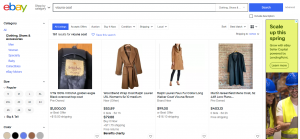Hi, and welcome to the List Perfectly Blog!
Stay tuned for Reseller stories, news, how-to guides, and of course, tips and tricks that will help you in your reselling business with List Perfectly.
 To get our brand new blog started, I’ll share the first chapter in a series about how my List Perfectly co-founder Clara and I setup and scaled our reselling business. You may or may not know that we were both resellers for many years before we founded List Perfectly. I started reselling in 2003, Clara joined me in 2009, and together we grew The Clothing Vault to a nearly half million dollar a year online vintage business.
To get our brand new blog started, I’ll share the first chapter in a series about how my List Perfectly co-founder Clara and I setup and scaled our reselling business. You may or may not know that we were both resellers for many years before we founded List Perfectly. I started reselling in 2003, Clara joined me in 2009, and together we grew The Clothing Vault to a nearly half million dollar a year online vintage business.
Clara and I spent a lot of time on creating the right systems and processes that worked best for us and the type of items we sold. We’ve hinted at some inventory systems in The Clothing Vault’s episodes on The Seller Community Podcast (episode one, episode two). As promised, I’ll be revealing many of our techniques in this series.
Everything I’ll be sharing is completely do-able for any level of business, requires no special equipment or software, and will allow anyone to scale fast.
So, let’s dive in on what I feel is the best advice to scaling up your reseller business:
The Clothing Vault – Processes Chapter 1 – Consistency
One of the best tips I can give anyone looking to scale up their reselling business is to work on it consistently.
Barring unforeseen circumstances, Consistent efforts usually equal Compounding results.
It doesn’t matter what type of seller you are: big or small, part time or full time, just starting out or in business for years; consistency will always give you greater results as time goes by if you focus on all aspects of your business regularly.
Some of the things you can do a little of every day:
Create new listings
 Create new listings any time you like and stockpile them for future consistent publishing on Marketplaces
Create new listings any time you like and stockpile them for future consistent publishing on Marketplaces
Have a goal to list some amount of new listings every week that works for you and your business. If you’re a weekend lister and like to list 10 items on Saturday for example, stockpile those new listings as drafts in List Perfectly.
Then, every day, post one or two of your stockpiled listings to marketplaces.
Drafts are a Pro plan feature, but you can be on any plan to find listings you haven’t launched yet. Use the List Perfectly Not filters to find listings that are either completely unlisted, or maybe listed on one or two marketplaces only.
When we managed our drafts in List Perfectly, we would use this technique to generate consistent sales. Marketplace algorithms like it when sellers list daily, and have been shown to favor those sellers in search.
Research top selling items often
Regularly we would look up what sold in categories we were selling in to see what was hot. It’s pretty easy to do this in ebay. You can use eBay’s advanced search, select a category and sold listings to view, then sort by highest price.
use eBay’s advanced search, select a category and sold listings to view, then sort by highest price.
Take the prices and comps lightly, as there could be some other factors driving up price having nothing to do with the item itself. The more you research, the more you’ll be able to spot what’s a real sale from what’s not.
Communicate and respond to your buyer’s or potential buyer’s messages quickly
The faster you can respond to legitimate messages, the faster you can make a sale.
Ship fast
Your buyer will be happy, and there’s less chance of a buyer getting buyer remorse.
Source regularly and often
If you’re selling pre-owned, one-of-a-kind, or retail arbitrage, visit or shop online from your favorite sources regularly. If you don’t buy it, chances are someone else will. There were hundreds of sources Clara and I would regularly shop from, and we had a goal to visit some, or all of them, at least once every 1-2 months. We were shopping at least 3 out of 7 days a week consistently.
Review and revise your existing listings
We would regularly look at our older listings and see if we could spruce them up. Maybe something as simple as changing picture order could make the difference. Even raising prices would work well for us. You don’t always have to drop prices to see a difference in sales. In the case where a listing had errors, this would be a good opportunity to delist and relist.
Delisting and relisting wasn’t something we’d do often unless the listing had errors or was older than a year. It takes time for search engines to find listings and make them available in search. We found it better to revise most of the time, which would usually give a bump in the search that we needed to make the sale.
Organize your inventory and work areas

There was always something Clara and I could do to be more efficient. Taking physical inventory regularly would free up space for more listing. Keeping our work area organized made it easier and more likely for us to enjoy our work. Listing similar items in one session made it easier to photo and draft listings. Using List Perfectly mobile to take pics directly in our LP catalog and save for later made it easier to finish listings from anywhere, even while standing in line at the grocery store.
Consistency = SALES
The more consistent you are the better you will get – and this is what I mean by results compounding.
If you’re just starting out, it might take you 30 minutes to create a new listing. You might want to research pricing and keywords, learn to take photos, set up listing templates (strongly recommended if using the LP catalog, available in all plans), etc.
Once you start listing more frequently, you’ll get your process down, and then you might be able to create 10 listings in 30 minutes.
And if you’re new to selling on a marketplace, it might take time for your shop to get established. You might go from selling 1 item a week to 10 per week in time.
Same with research. The more you know, the better at sourcing you’ll get.
In summary, consistency = SALES, which is the goal!




